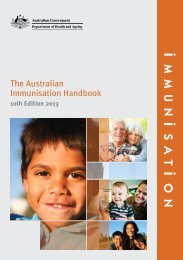Contents Chapter Topic Page Neonatology Respiratory Cardiology
Contents Chapter Topic Page Neonatology Respiratory Cardiology
Contents Chapter Topic Page Neonatology Respiratory Cardiology
You also want an ePaper? Increase the reach of your titles
YUMPU automatically turns print PDFs into web optimized ePapers that Google loves.
APNOEA IN THE NEWBORN<br />
Definition : Pause in breathing lasting > 15 sec (term) or >20sec (preterm) during<br />
which the infant may develop cyanosis (SpO2 < 80%) and bradycardia (heart rate <<br />
100 per min). In very immature infants, shorter duration of apnoea may produce<br />
bradycardia and cyanosis.<br />
Types: Central – absence of respiratory effort with no gas flow<br />
Obstructive – continued ineffective respiratory effort with no gas flow<br />
Mixed central and obstructive<br />
Periodic breathing – Regular sequence of respiratory pauses of 10-20 sec<br />
interspersed with periods of hyperventilation (4-15 sec) and occurring at least 3x/<br />
minute, not associated with cyanosis or bradycardia.<br />
Aetiology<br />
Symptomatic of underlying problems commoner ones of which are:<br />
1. <strong>Respiratory</strong> conditions – RDS, pulmonary haemorrhage, pneumothorax,<br />
Upper airway obstruction, respiratory depression 2 drugs<br />
2. Sepsis<br />
3. Hypoxaemia<br />
4. Hypothermia<br />
5. CNS abnormality e.g. IVH, asphyxia, increased ICP, seizures<br />
6. Metabolic disturbances – hypoglycaemia, hyponatraemia, hypocalcaemia<br />
7. Cardiac failure, congenital heart disease, anaemia<br />
8. Aspiration/ Gastro-oesophageal reflux<br />
9. NEC/ Abdomen distension<br />
10. Vagal reflex: Nasogastric tube insertion, suctioning, feeding<br />
Recurrent apnoea of prematurity<br />
- usually occur after 3 days of life with no other pathological conditions. Most<br />
disappear by 34- 36 weeks, but some may persist even after 40 weeks ‘corrected’<br />
gestation.<br />
Management<br />
1. Immediate resuscitation.<br />
Surface stimulation<br />
(Flick soles, touch baby)<br />
Gentle nasopharyngeal suction<br />
(Be careful: may prolong apnoea)<br />
Ventilate with bag and mask on previous FiO2.<br />
Be careful not to use supplementary oxygen if the infant has been in air as the child's<br />
lungs are usually normal and a high PaO2 may result in ROP.<br />
Intubate and IPPV if child cyanosed or apnoea recurrent/persistent
















